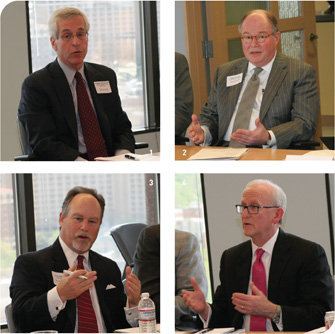
1. Joe Hiersteiner said relationships with accountants helped open doors to new clients. | 2. John Granda said Kansas City firms had been able to increase their profiles nationally because of better rates and high levels of service. | 3. Non-traditional legal services, noted Larry Frazen, have compelled law firms to provide better value for clients. | 4. Larry Tucker made the point that for those young attorneys who are talented and motivated, there will be no shortage of opportunities.
Bob Keim saw a difference between the way an attorney deals with small and mid-size firms and with larger corporations that have their own legal staffs. At large firms too, there has been little change in the way accountants and attorneys interact.
Joe Hiersteiner sees accountants less as competitors than as partners. “Keeping the accountant for a client happy is a good way to make sure that when the acquisition takes place, the accountant is talking to us about that acquisition as opposed to somebody else,” said Hiersteiner.
Larry Frazen observed that there was competition coming from “non-traditional deliverers of legal services.” He cited the discovery process, for instance, which is sometimes outsourced to considerably lower-paid lawyers in countries like India. Clients are demanding more for the same amount, said Frazen. “They want more value. I think clients understand that they have much more bargaining power now than they did.”
To Pete Smith’s point of whether an attorney should handle all of a client’s needs, Joe Hiersteiner said that yes, ideally, the client comes to the attorney first with any kind of legal problem. “We hope that the relationship with a client is such that they really wouldn’t think about talking to anybody else about any problems they have.” The attorney might well refer the problem on to another firm, but that first contact is critical, as is the assurance that a problem will be well handled.
Tom Stahl agreed. “You have to be willing to help those people, no matter what.” Again, the response may be a referral to another attorney, but referrals have to be trustworthy. Trip Frizell described the attorney’s role as “gatekeeper,” especially when dealing with smaller clients.
Young Attorneys
John Snyder shared with his colleagues the fact that his daughter is contemplating taking her LSATs and going to law school. He asked them, “Is she crazy?”
“I don’t think your daughter is crazy,” said Steve Carman, “but maybe you are.” As he explained, the traditional model of the pyramid-shaped law firm with a large group of young lawyers training and doing lower-level work is no longer a viable model, especially with clients outsourcing lower-level work to other service providers. As a consequence, the opportunities for the young lawyers to jump right into challenging transactions are getting smaller and smaller every day.
Mark Hinderks made the point that “there will always be room for smart people, especially those who are capable of forming relationships with clients.” Larry Tucker, managing attorney of the Armstrong Teasdale office in Kansas City, agreed. He told the story of the famed orator Daniel Webster who, when discouraged from becoming a lawyer because there were already too many—and this, two centuries ago—answered, “There’s always room at the top.” Said Tucker, “I think that’s still true.”
Carman didn’t disagree, but with so many trained lawyers available in Kansas City, law firms are shying from hiring new graduates. As Hinderks noted, “The thing that most of us are looking for are people who are both smart and personable and who can drive relationships.”
Law schools, unfortunately, don’t teach relationships. For Pete Smith, this is a shortfall. “I want them to go out there and learn the small little chicken stuff for three or four years,” said Smith of young lawyers.
The entry-level job is going to be more difficult to find, confirmed Joe Hiersteiner. Placement counselors at the law schools have reported that far fewer firms are coming to interview than ever before, and far fewer firms are hiring people right out of school. For the new hires, though, he did not see a real difference in the kind of experience they will have.
For firms like Baker Sterchi Cowden & Rice, where Scott Kreamer serves on the executive board, the slowdown in hiring out of law school has given his partners the opportunity to hire new lawyers that they would not have been able to get in the past.